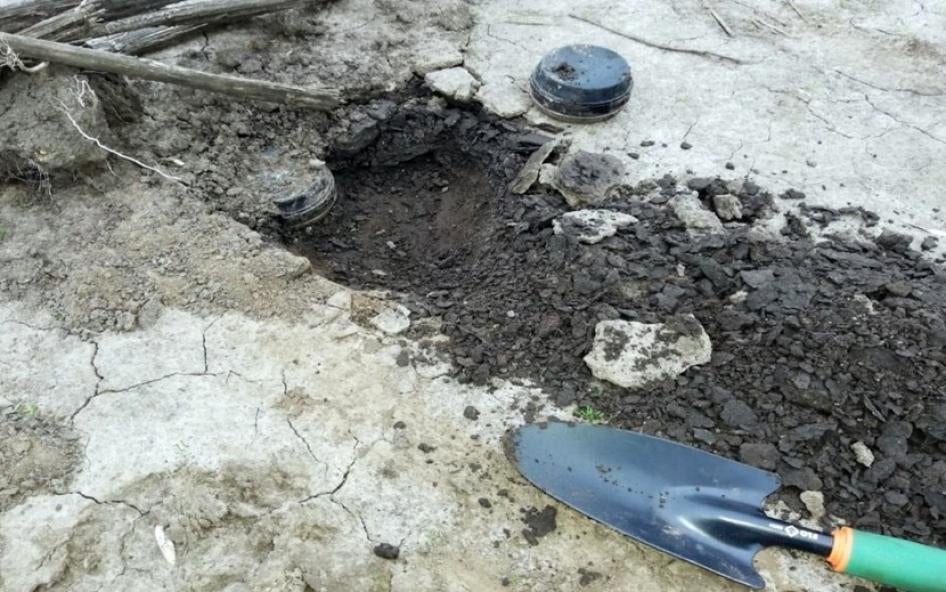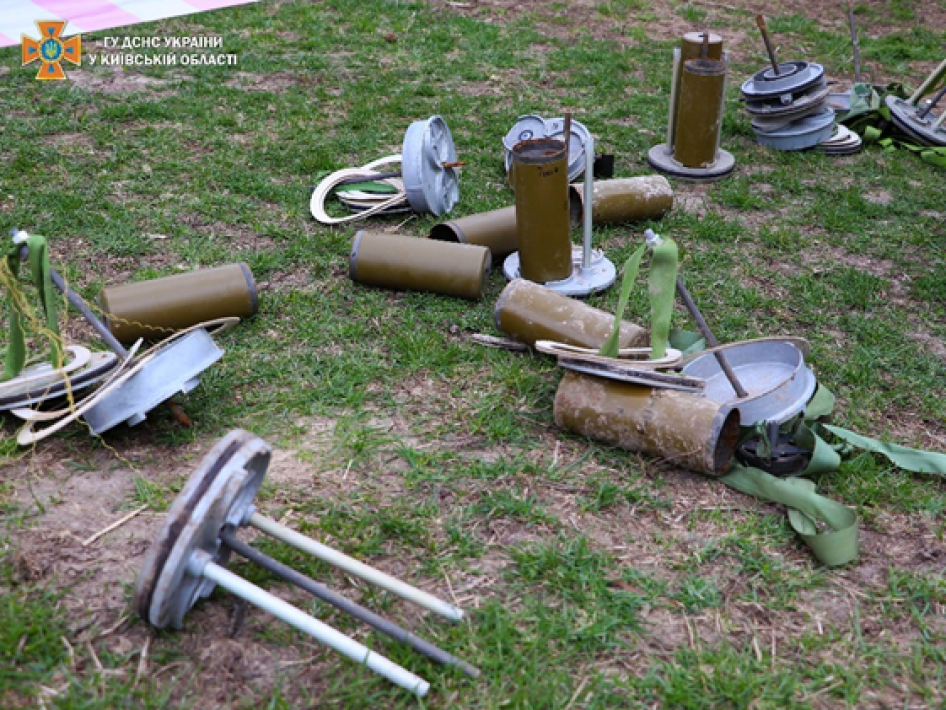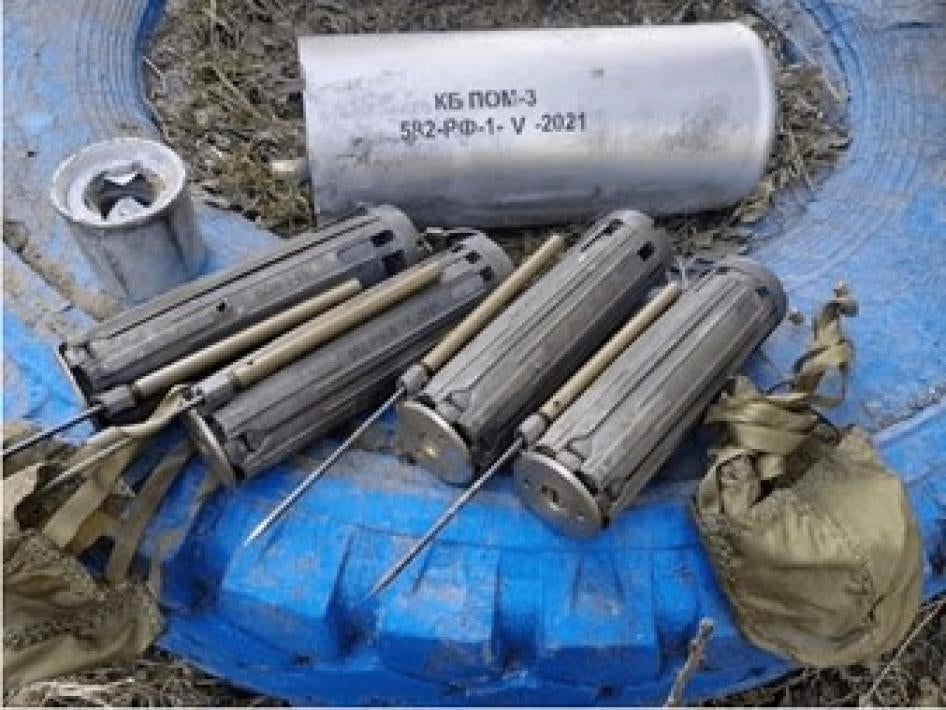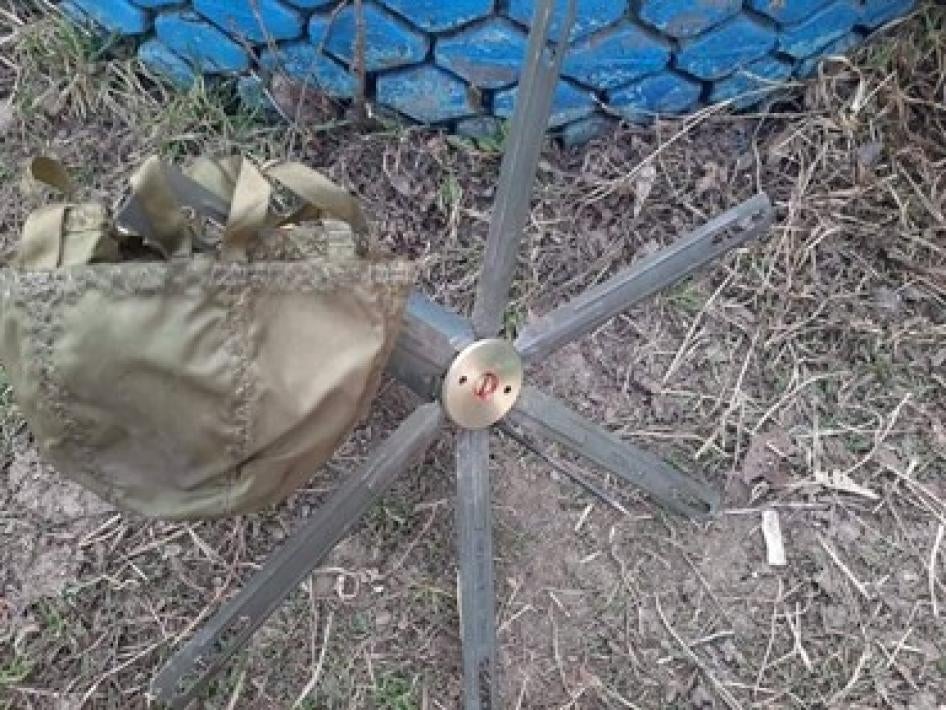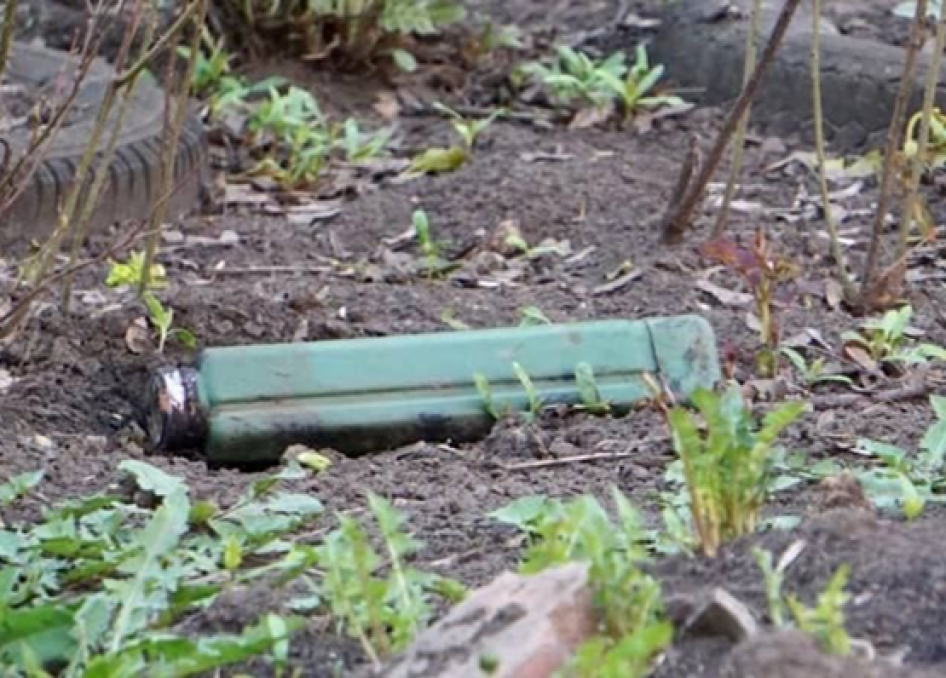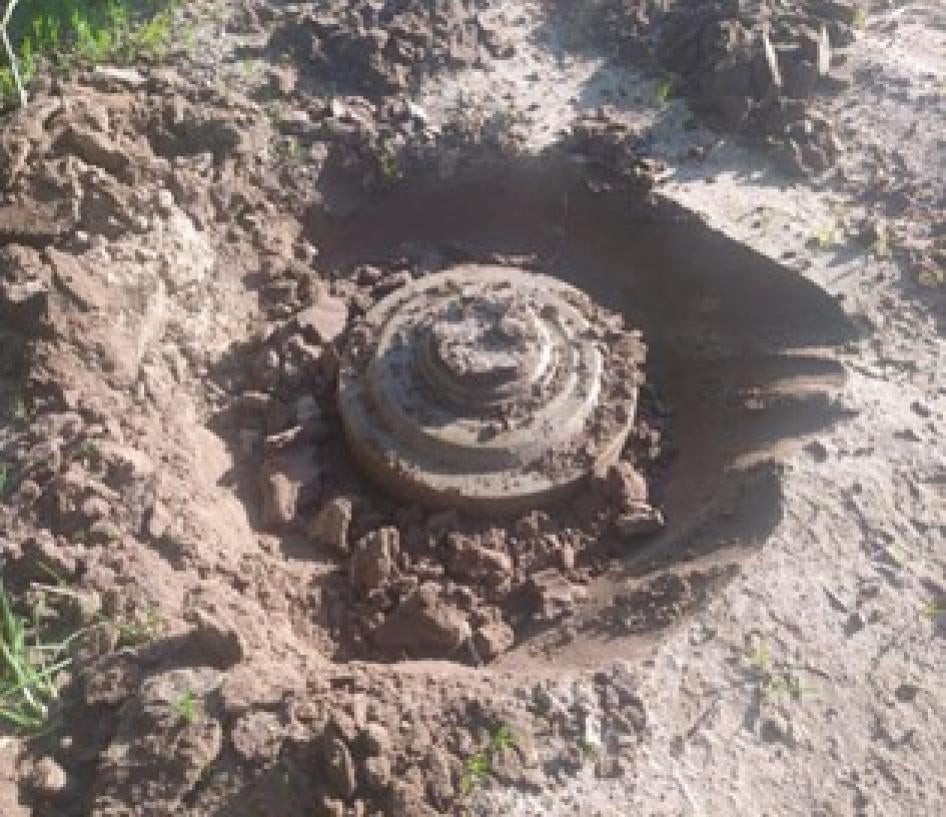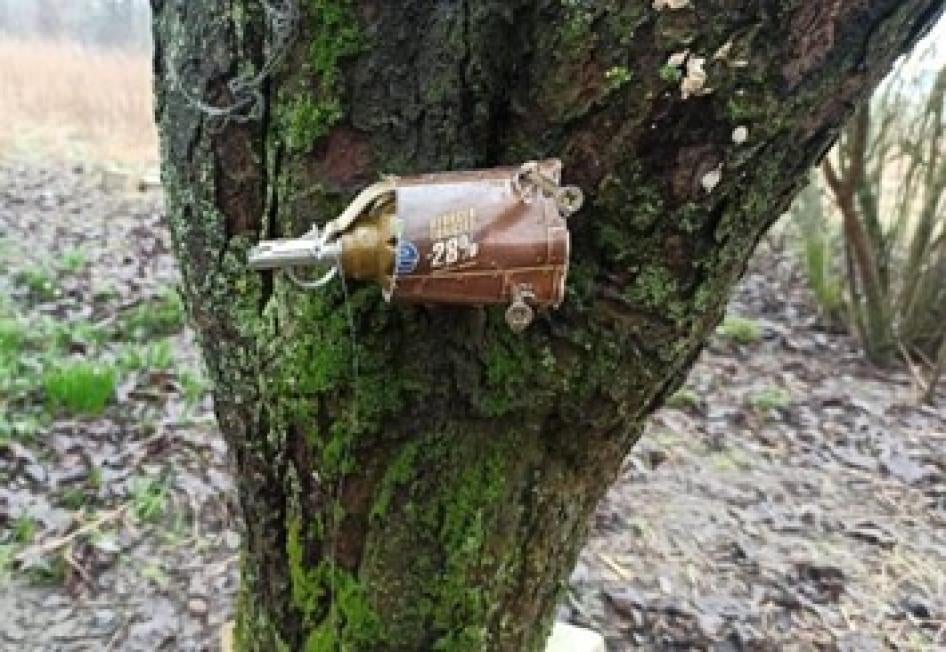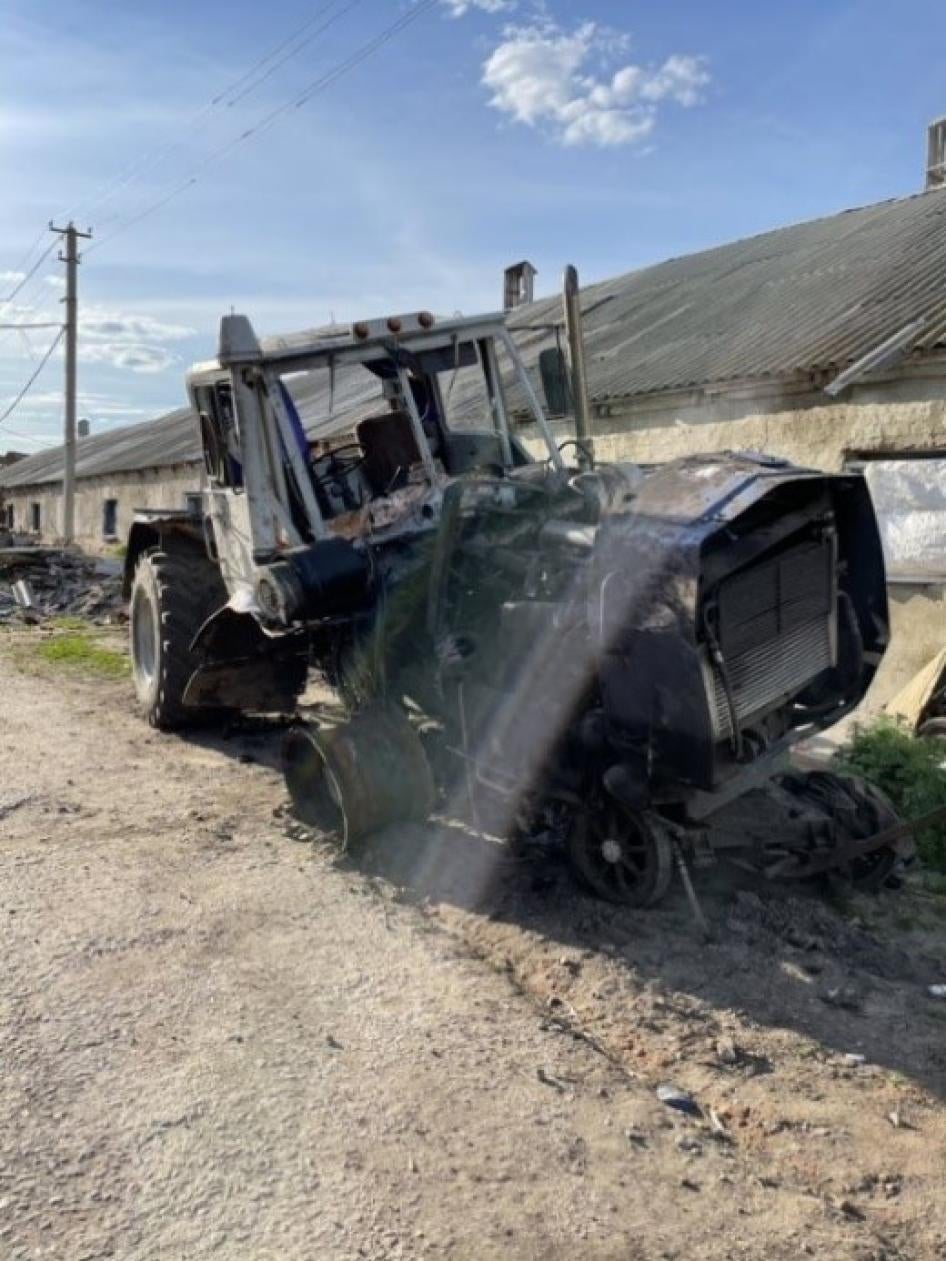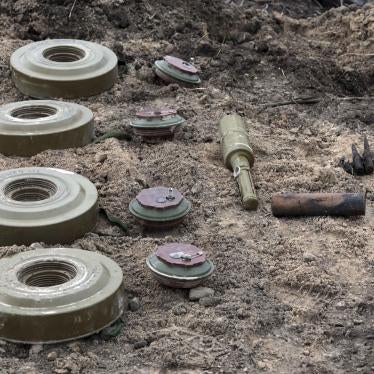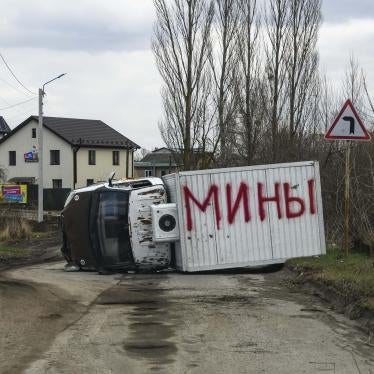This Background Briefing surveys the types of landmines used in Ukraine since the full-scale Russian invasion began on February 24, 2022. It is not currently possible to systematically determine the number of landmines casualties or the humanitarian impact of new mine use since the invasion.
Summary
Russian forces have used at least seven types of antipersonnel mines in at least four regions of Ukraine: Donetsk, Kharkiv, Kyiv, and Sumy. This marks an unusual situation in which a country that is not party to the 1997 Mine Ban Treaty uses the weapon on the territory of a party to the treaty.[1]
There is no credible information that Ukrainian government forces have used antipersonnel mines in violation of the Mine Ban Treaty since 2014 and into 2022.
Both Russian and Ukrainian forces have extensively used anti-vehicle mines (also called anti-tank mines) in at least six regions: Donetsk, Chernihiv, Kharkiv, Kyiv, Odesa, Sumy, and Zaporizhzhia. Hand-emplaced TM-62 series anti-vehicle mines appear to be the type most frequently used.
All manner of landmine delivery methods have been documented: hand-emplaced, mechanically-laid, and remotely-delivered. Several new, never-before-seen landmines have made their combat debut in the armed conflict, including some produced as late as 2021.
Russian forces have also emplaced many victim-activated booby-traps as they retreated from positions taken during the initial phase of the invasion. Booby-traps can function as antipersonnel mines when the fuze that is used is activated unintentionally by a person.
Landmine casualties have been reported in the conflict in Ukraine and the impact of new mine use can also be seen in the denial of access to civilian homes, infrastructure, transportation routes, and agricultural lands. Evidence indicates that agricultural production is being affected by the use of landmines in fields and on rural paths and roads.
Russia-backed forces in eastern Ukraine previously used landmines in Donetsk and Luhansk regions in 2014-2015 and sporadically in the following years, including antipersonnel mines, anti-vehicle mines, and victim-activated booby-traps.[2] Ukraine’s armed forces and security services have regularly confiscated caches of antipersonnel mines in Donetsk and Luhansk regions, including MON-50 directional mines,[3] MON-90 directional mines,[4] PMN-1 and PMN-2 blast mines[5], OZM-72 bounding fragmentation mines,[6] and POM-2 mines.[7]
The 1997 Mine Ban Treaty comprehensively prohibits all types of victim-activated explosive devices, regardless of the technical features and regardless of the mine’s predicted longevity, delivery method, or type of manufacture (improvised or factory-made).[8] Ukraine signed the Mine Ban Treaty on February 24, 1999 and became a state party on June 1, 2006. Russia has not joined the treaty, but is bound by the prohibitions and restrictions on mines, booby-traps, and other devices found in Amended Protocol II of the UN Convention on Conventional Weapons (CCW), as well as Protocol I to the Geneva Conventions and customary international humanitarian law. Belarus, which is supporting Russia’s invasion of Ukraine, acceded to the Mine Ban Treaty on September 3, 2003, and became a state party on March 1, 2004.[9]
Recommendations
All parties to the armed conflict in Ukraine are obligated to ensure that no antipersonnel mines are used by any actor and destroy any antipersonnel mines that they have seized or otherwise acquired.
- Ukraine needs to ensure that its forces respect their obligations under the Mine Ban Treaty in all circumstances. The Ukrainian government should confirm that remaining stockpiles of PFM-type antipersonnel mines currently in storage awaiting destruction cannot be used in combat operations.
- Russia needs to fully abide by the prohibitions and restrictions of CCW Amended Protocol II including the detectability and reliability of any mines it uses in this conflict as well as marking, monitoring, and ensuring the effective exclusion of civilians from these mined areas.[10]
- As a party to the Mine Ban Treaty, Belarus needs to ensure that its joint military operations with Russia do not violate the prohibition on assisting, encouraging or inducing a non-party to engage in activities prohibited by the treaty.[11] This means avoiding participating in the planning for use of antipersonnel mines; not committing to rules of engagement that permit use of antipersonnel mines; not accepting orders to use, request others to use, or train others to use antipersonnel mines, not knowingly deriving military benefit from the use of the weapon by others; and not providing security, storage, transportation or transit for antipersonnel mines.
Methodology
This Background Briefing draws on information collected, including from witness accounts, by Human Rights Watch researchers in Ukraine. It also relies on several other sources, including:
- Verified videos and photos, obtained directly or via social media, showing landmines or evidence of their use.
- Information shared with Human Rights Watch by international and national demining experts and armament research specialists.
- Technical publications including the Explosive Ordnance Identification Guide for Ukraine (1st ed.) published by the Geneva Centre for Humanitarian Demining in May 2022 and Jane’s Mines and Mine Clearance 2008 yearbook published by Jane’s Information Group. Also consulted was “Russia’s Arms Catalog: Volume 1 – Army, 1996-1997,” published by Military Parade.
- Reference and identification materials aggregated and shared on social media by specialist organizations including CAT-UXO.com, Armament Research Services, Fenix-Insight, and the Collaborative Ordnance Data Repository. Special appreciation to @JakeGodin, @N_Waters89, @blueboy1969, @johnismay, @oryxspioenkop, and @RALee85.
- Displays of weaponry seized or recovered by the governments or militaries of the parties to the conflict.
- Landmine Monitor Report mine ban profiles of Russia and Ukraine.[12]
This document should be considered an interim overview because active hostilities continue and access by independent observers to battlefield areas remains limited. Some of the data presented here is taken from government sources or posted to social media by third parties and should be treated with care, particularly in attributing responsibility for landmines use and its compliance with treaty obligations and international humanitarian law.
I. Types of Landmines Used in Ukraine in 2022
Human Rights Watch has identified at least seven types of antipersonnel mines and six types of anti-vehicle mines used through June 2022 in the war in Ukraine (see table below). Russia is the only party to the conflict known to have used antipersonnel mines and both Russia and Ukraine have used anti-vehicle mines. All manner of landmine delivery methods have been documented: hand-emplaced, mechanically-laid, and remotely-delivered.
All antipersonnel landmines used by Russian forces were manufactured by the Russian Federation or its predecessor state, the Soviet Union.
With some notable exceptions, most hand-emplaced landmines identified by Human Rights Watch are of Soviet-origin, with production markings from the 1970s and 1980s, and have been stockpiled by both Ukraine and Russia. More modern remotely-delivered mines, some with markings indicating production in 2021, have also been used by Russian forces.
|
Category |
Designation |
Origin |
Type |
Initiation |
Used in 2014-2015? |
|---|---|---|---|---|---|
|
Antipersonnel |
MON-50 |
USSR/Russia |
Fragmentation |
Tripwire/command |
Yes |
|
MON-100 |
USSR/Russia |
Fragmentation |
Tripwire/command |
Yes |
|
|
OZM-72 |
USSR/Russia |
Fragmentation |
Tripwire/command |
Yes |
|
|
PMN-4 |
Russia |
Blast |
Pressure |
Yes |
|
|
POM-2/ POM-2R |
USSR/Russia |
Fragmentation |
Tripwire/self-destruct |
|
|
|
POM-3 |
Russia |
Fragmentation |
Seismic |
|
|
|
Anti-vehicle |
PTKM-1R |
Russia |
Shaped-charge |
Top-attack |
|
|
PTM-1/PTM-1G |
USSR/Russia |
Blast |
Pressure/self-destruct |
Yes |
|
|
PTM-4M |
Russia |
Shaped-charge |
Magnetic influence |
|
|
|
TM-62M |
USSR/Russia |
Blast |
Pressure |
Yes |
|
|
TM-62P3 |
USSR/Russia |
Blast |
Pressure |
|
MON-series antipersonnel mine
MON-series mines are a family of hand-emplaced directional fragmentation munitions that are designed for use to various distances or as warheads for booby-traps.[13] Ukrainian deminers in Bucha told Human Rights Watch that they found victim-activated booby-traps incorporating MON-series mines emplaced in the town by Russian forces prior to their withdrawal.[14]
MON-series munitions are multi-purpose antipersonnel munitions that can be emplaced either in a command-detonated or victim-activated manner. When used in victim-activated mode with a mechanical pull, tension release, or seismic fuze, they are prohibited by the Mine Ban Treaty. There were a large number of reports and photographs of MON-series directional fragmentation mines being seized or recovered in eastern Ukraine from 2014 onwards.[15]
OZM-72 antipersonnel mine
The OZM-72 bounding fragmentation antipersonnel mine is a multi-purpose munition that can be emplaced either in a command-detonated or victim-activated manner.[16] When used in victim-activated mode with a mechanical pull, tension release, or seismic fuze, they are prohibited by the Mine Ban Treaty. Prior to 2022 there were frequent reports of OZM-72 mines being sighted, seized, or recovered in eastern Ukraine.[17] According to local Ukrainian police, on May 19, two men were killed by an OZM-72 mine that police said was emplaced by Russian troops in a field between the villages of Lypivka and Korolivka in Bucha district of Kyiv region.[18]
Ukraine possessed stocks of OZM-72 antipersonnel mines in the past, but it is unclear if it still has them.[19]
PMN-4 antipersonnel mine
The PMN-4 antipersonnel blast mine was first publicly displayed by Russia in 1993. It has never been stockpiled by Ukraine.[20] Ukrainian police reportedly located and cleared two PMN-4 mines and two OZM-72 mines near the village of Malyyy Vystorop in the Sumy region on April 12.[21]
POM-2 and POM-2R antipersonnel mines
The POM-2 antipersonnel mine is a tripwire activated, bounding fragmentation antipersonnel mine delivered by helicopter, ground-fired rockets, or other means.[22] Video and photographs released by Ukrainian national police after two women were killed by a landmine near the town of Tsyrkuny north of Kharkiv show POM-2 mines and their delivery cannisters.[23]
In 2020 and 2021, Russia-backed forces in eastern Ukraine fabricated and used an improvised antipersonnel mine by combining a POM-2 mine with the rocket motor of a rocket-propelled grenade to create a short range, remotely-delivered antipersonnel mine system.[24] Russian forces were filmed using these weapons near Horlivka in Donetsk region on May 21.[25]
Kharkiv emergency services photographed the remotely delivered POM-2 mines and their KPOM-2 dispensers near villages in the Brovary and Vyshgorod districts of the Kyiv region on April 17.[26] Additional POM-2 antipersonnel mines and TM-62M anti-vehicle mines were photographed together in a mined area in the forest near the village of Stara Buda, northwest of Kyiv on April 20.[27] Additional POM-2 antipersonnel mines were photographed at other locations in the Kyiv region.[28]
The POM-2R is a factory-produced variant of the POM-2, designed for use in conjunction with a URP igniter assembly, allowing manual hand-emplacement.[29]
POM-2 and POM-2R mines are stockpiled by Russia, but not by Ukraine.
POM-3 antipersonnel mine
Human Rights Watch has reported on the use by Russian forces of the remotely-delivered POM-3[30] antipersonnel mine also known as “Medallion.”[31] These antipersonnel mines were located by Ukrainian explosive ordnance disposal technicians near Kharkiv city on March 28, 2022. The rockets that delivered the mines were launched from specially designed multi-barrel ground launch vehicles that were recorded on video on an unknown date and posted to social media on March 26.[32]
This never-before-seen-in-combat antipersonnel bounding fragmentation mine is equipped with a seismic proximity fuze that makes it prone to destruct when approached. The mine launches to a height of 1 to 1.5 meters then detonates midair, producing fragments that are lethal up to about 16 meters away. The POM-3 also has a self-destruct feature that sets the mine to explode after a certain period.
Markings on a remnant of a delivery canister pictured with POM-3 mines that failed to deploy properly indicate it was newly produced in 2021. The consultancy Armament Research Services has produced a detailed technical reference for POM-3 antipersonnel mines.[33]
The ISDM Zemledelie-I mine-laying rocket launcher delivers the POM-3 mines from 5 to 15 kilometers away. It was first publicly displayed during annual Russian military exercises in 2021.[34] Anti-vehicle mines can also be deployed by the ISDM launcher.[35] The POM-3 can also be scattered at short range by other types of truck-mounted launchers.
Ukraine does not possess the POM-3 mine or its delivery system.
PTKM-1R anti-vehicle mine
The Russian PTKM-1R is a modern and novel anti-vehicle mine system.[36] The mine cannister is hand-emplaced and its sensors detect the seismic and thermal signatures of vehicles to distances of 200 to 300 meters. Once a target is detected, a sensor-fuzed submunition is ejected into the air and scans for a precise target. Once a target is located, a shaped charge is fired downwards onto the top of the target. On April 26, photographs of the PTKM-1R anti-vehicle mine circulated on social media.[37]
PTM-1 and PTM-1G anti-vehicle mines
The PTM-1/PTM-1G is a remotely-delivered, plastic-cased anti-vehicle mine with a soft plastic explosive filling and hydraulic self-destruct mechanism.[38] This mine is delivered from helicopter, 122mm Grad rocket system, and—as seen in Ukraine—by the 9M27K2 Uragan 220mm rockets to a minimum range of 10 kilometers and a maximum range of 35 kilometers. Each 9M27K2 rocket contains 24 mines.
The New York Times first documented the use and subsequent clearance of PTM-1/PTM-1G anti-vehicle mines in a neighborhood in eastern Kharkiv city on April 8.[39] During the hours between its use and the emergency response clearance process, many of the mines self-destructed at random intervals, increasing the dangers to nearby civilian and clearance personnel.
Numerous PTM-1/PTM-1G mines were subsequently encountered and cleared by Kharkiv emergency services on April 11.[40] The Kharkiv prosecutor’s office posted detailed photographs of PTM-1/PTM-1G mines on April 12 in the Nemyshlyanskyi and Kyivskyi districts.[41] Ukrainian Public TV recorded video of clearance personnel encountering PTM-1/PTM-1G mines in another village in the Kharkiv region on April 27.[42]
Ukrainian security services also documented the presence of this type of mine in the Donetsk region on April 30.[43] PTM-1/PTM-1G mines were found and cleared by Donetsk emergency services on May 12, in the Kramatorsky and Pokrovsky districts.[44] Additional PTM-1/PTM-1G mines were found by the Ukrainian national police in the villages of Yelizavetovka and Kostiantynivka in the Maryinsky district on May 25.[45]
The use of PTM-1/PTM-1G remotely delivered mines is not limited to the Russian armed forces. Russia-backed fighters in the “Donetsk People’s Republic” displayed remnants of PTM-1G mines and a 9M27K2 220mm Uragan artillery rocket on April 27.[46] Other images of the remnants of 9M27K2 mine-dispensing rockets were photographed on April 26.[47]
PTM-4M anti-vehicle mine
The PTM-4 is a modern remotely delivered, magnetic influence anti-vehicle mine with a shaped charge that is delivered by a variety of means including vehicle and helicopter-mounted dispensers. The suffix “M” indicates a modernized version of the original item. On May 30, Kharkiv region police investigated battle damage in the town of Elitne and photographed a delivery cannister marked as “ПТМ-4М” (PTM-4M).[48] This mine has not been documented previously and the marking on the disperser indicate production in 2021.[49]
TM-62 series anti-vehicle mine
The most numerous mine type identified in use in the conflict is the hand-emplaced TM-62M anti-vehicle mine equipped with MVCh-62 pressure activated fuze.[50] TM-62-series anti-vehicle mines appeared in social media from the outset of the conflict. One February 27 video shows a man removing a fuzed TM-62 series mine from a road near the port city of Berdyansk.[51] There is also evidence of Ukrainian military forces using a mechanical mine-layer to emplace TM-62M mines on the beaches near the city of Odesa.[52]
Also in use is the low metal content TM-62P3 anti-vehicle mine with MVP-62M low metal content pressure-activated fuze.[53] These mines were filmed in Kharkiv oblast in May.[54] This mine use was attributed to the Ukrainian battalion named “Stugna.”
Victim-activated booby-traps
In mid-April 2022, Ukrainian police and emergency services in the Kharkiv region distributed numerous images of victim-activated booby-traps that were emplaced by retreating Russian forces.[55] One example of a victim-activated booby-trap used is a hand grenade with a trip wire attached as an initiating mechanism that when disturbed explodes the grenade.
Human Rights Watch spoke with the head of the Ukrainian government’s demining unit for Bucha region, Lt. Col. Roman Shutylo, as well as the commander of an anti-tank brigade assisting with demining in Bucha, Ihor Ostrovsky. Both said that victim-activated booby-traps had been used in the town. Shutylo said that on April 8 the deminers had found two dead bodies that had victim-activated booby-traps placed on them. In total, they found 20 victim-activated boobytraps and antipersonnel mines, including those constructed with the F-1 and RGD-5 fragmentation hand grenades, as well as MON-50, MON-100, and OZM-72 mines.[56]
Ostrovsky shared video of an ordnance item attached to wire, which he said was found in a yard in Bucha, that had been configured to detonate when enough tension was exerted on the wire. The demining team said they found at least one other similar device in a building that Russian troops had occupied. A third deminer in Bucha showed Human Rights Watch a photograph on his phone that he took of one of the two victim-activated improvised explosive devices his team uncovered in Bucha.[57]
Other types of mines
Other types of mines reported in the Ukraine conflict by various sources and media outlets have not been included in this interim accounting for various reasons. Some have dubious sourcing, visual materials that appear to be staged, or appear to show mines from displays and inert models of mines and explosive remnants of war used for recognition or risk education training.
Media outlets have sporadically circulated pictures and videos showing remotely delivered PFM-1 series antipersonnel mines lying in situ. The Sumy Regional Military Administration issued a warning to Sumy residents on March 17 after it alleged that Russian aircraft used PFM-1 antipersonnel mines during night raids.[58] Another video reportedly taken in Popasna town in the Sievierodonetsk district of Luhansk region on April 4 shows a few individual PFM-1 mines.[59] A video recorded May 26 appears to show the remnants of the 9M27K3 220mm mine-dispensing rocket that allegedly hit the Russian-controlled village of Novovoskresenske in Kherson oblast. [60]
This interim briefing note does not cover mines other than antipersonnel landmines that have been transferred to Ukraine by other countries as military assistance. Germany has provided Ukraine with DM-22/PARM-2 off-route and DM-31 magnetic influence/shaped charge anti-vehicle mines.[61] The United States has transferred commanded-detonated M18A1 Claymore mines (without their victim-activated fuzes).[62]
This briefing note also does not address sea mines or anti-landing mines such as the PDM-1M.
II. Impact of Landmines on Ukrainian Civilians
Landmine casualties have been reported in the conflict in Ukraine, but many may go unrecorded, especially if the victim was alone at the time of the incident. The impact of landmine use can also be seen in the denial of access to civilian homes, infrastructure, transportation routes, and agricultural lands.
During the 2022 sowing season, using tractors in agricultural fields and while traveling on rural paths and roads has become a high-risk activity. There have been at least 10 reports of tractors detonating landmines in the Kyiv region since the start of the conflict.[63] Most recently, on May 19, a man was injured when the tractor he was driving hit a landmine in the village of Andriyivka near Makarov.[64] The Ukrainian State Emergency Service reported that a man in the Chernihiv region was injured on May 19 when his tractor hit a landmine.[65]
A farm owner in the village of Malaya Rohan, about four kilometers east of Kharkiv city, told Human Rights Watch that his employee was ploughing fields in mid-May when the tractor hit a landmine emplaced by Russian forces. The driver was not wounded, but the tractor was severely damaged. The incident took place in a field between Malaya Rohan and Stepanky village, both of which Russian forces had occupied from February 25 to March 26. A deminer from Ukrainian emergency services who cleared the site said that Russian forces were responsible and that two more TM-62 mines were found 100 meters away on a dirt road in the field. Local residents told Human Rights Watch that the withdrawing Russian forces did not clear the mines they had emplaced, provide any warnings to avoid the area, or share maps of the mine locations.
Currently, there is no systematic reporting on the number of mine incidents and victims, nor is any disaggregated casualty information available publicly. However, there are isolated reports such as on June 7, an unknown number of civilians were injured when the van they were using to collect firewood detonated a landmine in a forest outside Kyiv.[66]
III. Mine Ban Treaty and the International Response
All parties to the conflict in Ukraine are bound by treaties that prohibit or regulate landmines.
Ukraine signed the 1997 Mine Ban Treaty comprehensively prohibiting antipersonnel mines on February 24, 1999 and became a state party on June 1, 2006. There is no credible information that Ukrainian government forces have used antipersonnel mines in violation of the Mine Ban Treaty since 2014 and into 2022. Russia has alleged that Ukraine has violated the treaty but has not offered any information or details.
Russia has not joined the Mine Ban Treaty. However, it is bound by the prohibitions and restrictions on mines, booby-traps, and other devices found in Amended Protocol II of the UN Convention on Certain Conventional Weapons.[67] Russia is also bound by prohibitions against deliberate, indiscriminate and disproportionate attacks against civilians found in the First Additional Protocol to the Geneva Conventions of 1949 (Protocol I)[68] and customary international humanitarian law.[69]
Ukraine is also party to CCW Amended Protocol II but their obligations on antipersonnel mines are superseded by the stricter prohibitions contained in the Mine Ban Treaty.
Since March 28, 2022, Ukraine and at least seven other countries have condemned or expressed concern at Russia’s use of antipersonnel landmines in Ukraine: Austria, Belgium, Colombia, Italy, Poland, New Zealand, and the United States.[70]
Landmine use in Ukraine has also been condemned by the Mine Ban Treaty president and its special envoy for universalization, as well as by US congressional representatives such as Senator Patrick Leahy.[71] The International Campaign to Ban Landmines, 1997 Nobel Peace Laureate, has condemned the use of landmines in Ukraine, as has its members organizations, including its chair Human Rights Watch.[72]
In November 2020, Russia told the United Nations General Assembly that it “shares the goals of the treaty and supports a world free of mines,” but views antipersonnel mines “as an effective way of ensuring the security of Russia’s borders.”[73]
[1] Convention on the Prohibition of the Use, Stockpiling, Production and Transfer of Antipersonnel Mines and on their Destruction, adopted 18 September 1997, entered into force March 1, 1999. http://www.icbl.org/media/604037/treatyenglish.pdf (accessed June 8, 2022).
[2] For evidence of production markings from 2003, see Security Service of Ukraine (SBU), “SBU reveals three hidings with ammunition and Russian mine in ATO area,” November 15, 2016, https://sbu.gov.ua/en/news/463/category/21/view/2256#.LbMm7tkr.dpbs (accessed June 9, 2022); and for evidence of markings from 2010, see Ukrainian Military TV, “Prove the presence of Russian mines in Donbas,” YouTube.com, March 1, 2017.
[3] Ukrainian Military TV, “Prove the presence of Russian mines in Donbas,” YouTube.com, March 1, 2017. SBU, “SBU reveals 2 Russian mines in ATO area,” May 2, 2017, https://sbu.gov.ua/en/news/412/category/21/view/3281#.q8TDrl7q.dpbs (accessed June 9, 2022); SBU, “SBU seizes landmines produced in Russia in the ATO area,” April 25, 2017, https://www.sbu.gov.ua/en/news/158/category/21/view/3227#.w58OZ9li.dpbs (accessed June 9, 2022); and SBU, “SBU reveals cache with explosives in ATO area,” January 16, 2017, https://www.sbu.gov.ua/en/news/155/category/78/view/2553#.aTGYbYgn.dpbs (accessed June 9, 2022).
[4] SBU, “SBU finds two caches of arms and munitions during anti-terrorist operations,” August 30, 2017, http://193.29.204.72:8080/ua/news/365/category/21/view/3842#.MaCfjzv0.dpbs (accessed June 9, 2022).
[5] “A stockpile of antipersonnel mines retrieved from a separatist storage position,” Instagram post by bring_me_the_swampy, September 23, 2017, https://www.instagram.com/p/BZZIg4_nnDx/?taken-by=bring_me_the_swampy (accessed June 9, 2022); SBU, “SBU reveals cache with mines, explosives and anti-tank grenade launchers in ATO area,” April 27, 2017, https://www.sbu.gov.ua/en/news/128/category/78/view/3253#.8W5NNxHP.dpbs (accessed June 9, 2022); SBU, “SBU seizes ammunitions of Russian origin in the ATO area,” April 11, 2017, https://www.sbu.gov.ua/en/news/131/category/78/view/3146#.AKYZQbb8.dpbs (accessed June 9, 2022); SBU, “SBU records militants using weapons of Russian production,” April 1, 2017, https://www.sbu.gov.ua/en/news/1/category/1/view/3085#.xM1gyOfw.dpbs (accessed June 9, 2022); and SBU, “SBU reveals prohibited mines in ATO area that are in operational service with Russian army,” May 16, 2017, https://www.sbu.gov.ua/en/news/1/category/21/view/3354#.x2g7VqDH.dpbs (accessed June 9, 2022).
[6] SBU, “SBU removes the military munitions,” September 21, 2018, https://www.sbu.gov.ua/en/news/1/category/1/view/5236#.7oLAVdqe.dpbs (accessed June 9, 2022); SBU, “SBU blocks illegal sale of arms,” September 19, 2018, https://www.sbu.gov.ua/en/news/1/category/1/view/5224#.b696vn6V.dpbs (accessed June 9, 2022); and SBU, “SBU uncovers ammunition of Russian production in ATO area,” December 16, 2017, https://www.sbu.gov.ua/en/news/1/category/1/view/4219#.LB2PfdDU.dpbs (accessed June 9, 2022).
[7] Swampy, “Clearance around forward positions,” Beyond the Borders, October 27, 2017 (no longer available online); SBU, “SBU prevents terrorist attacks prepared by Russian secret services in Mariupol,” August 17, 2017, https://www.sbu.gov.ua/en/news/107/category/78/view/3793#.9eHICbzr.dpbs (accessed June 9, 2022); SBU, “SBU deactivates mine of Russian production in ATO area,” April 26, 2017, https://www.sbu.gov.ua/en/news/373/category/21/view/3236#.oyTXnw46.dpbs (accessed June 9, 2022); and SBU, “SBU reveals three hidings with ammunition and Russian mine in ATO area,” November 15, 2016, https://www.sbu.gov.ua/en/news/1/category/1/view/2256#.Iyvz95Vv.dpbs (accessed June 9, 2022).
[8] The Mine Ban Treaty prohibits antipersonnel mines, but not anti-vehicle mines or command-detonated (remote-controlled) mines. Other international agreements provide weak restrictions on the use of anti-vehicle mines. http://www.icbl.org/media/604037/treatyenglish.pdf (accessed June 8, 2022).
[9] International Campaign to Ban Landmines, Landmine Monitor Report 2019, Belarus chapter, http://www.the-monitor.org/en-gb/reports/2021/belarus/mine-ban-policy.aspx (accessed June 8, 2022).
[10] United Nations Convention on Certain Conventional Weapons, Amended Protocol II, “Protocol on Prohibitions or Restrictions on the Use of Mines, Booby-Traps and Other Devices,” as amended on 3 May 1996, https://geneva-s3.unoda.org/static-unoda-site/pages/templates/the-convention-on-certain-conventional-weapons/PROTOCOL%2BII.pdf (accessed June 9, 2022).
[11] Landmine and Cluster Munition Monitor Factsheet, Mine Ban Treaty Special Issues of Concerns (Articles 1, 2, 3), June 2014, http://www.the-monitor.org/media/1464902/BanFactSheet_SpecialIssues_Final.pdf (accessed June 8, 2022).
[12] International Campaign to Ban Landmines, Landmine Monitor Report, Russia and Ukraine chapters. See http://www.the-monitor.org/en-gb/our-research/country-profiles.aspx (accessed June 8, 2022).
[13] The numbers associated with each model of the MON family indicate the range, from 50 to 200 meters. According to Jane’s Mines and Mine Clearance (2008), each model contains a specific number of pre-formed fragments that are projected horizontally. The MON-50 contains 540 ball bearings or 485 pieces of 5mm chopped steel rod and the MON-100 contains 400 pieces of 10mm chopped steel rod.
[14] Human Rights Watch, Ukraine: Russian Forces’ Trail of Death in Bucha, April 12, 2022.
[15] Ukrainian Military TV, “Prove the presence of Russian mines in Donbas,” YouTube.com, March 1, 2017. SBU, “SBU reveals 2 Russian mines in ATO area,” May 2, 2017, https://sbu.gov.ua/en/news/412/category/21/view/3281#.q8TDrl7q.dpbs (accessed June 9, 2022); SBU, “SBU seizes landmines produced in Russia in the ATO area,” April 25, 2017, https://www.sbu.gov.ua/en/news/158/category/21/view/3227#.w58OZ9li.dpbs (accessed June 9, 2022); and SBU, “SBU reveals cache with explosives in ATO area,” January 16, 2017, https://www.sbu.gov.ua/en/news/155/category/78/view/2553#.aTGYbYgn.dpbs (accessed June 9, 2022).
[16] OZM-72 Landmine Description, Collective Awareness to UXO, https://cat-uxo.com/explosive-hazards/landmines/ozm-72-landmine (accessed June 8, 2022).
[17] “Особо опасная группа из 12 диверсантов, причастная ко взрыву в харьковском пабе, задержана, - СБУ. ФОТОрепортаж,” Censor, November 17, 2014, http://censor.net.ua/photo_news/312355/osobo_opasnaya_gruppa_iz_12_diversantov_prichastnaya_ko_vzryvu_v_harkovskom_pabe_zaderjana_sbu_fotoreportaj (accessed March 25, 2015).
[18] “2 men killed by Russian mine in Kyiv oblast field, Ukrainska Pravda, May 19, 2022, https://www.pravda.com.ua/eng/news/2022/05/19/7347116/ (accessed June 8, 2022).
[19] In its Mine Ban Treaty Article 7 reports submitted in 2007, 2008, and 2009, Ukraine also noted that while its OZM- 72 antipersonnel mines could be used in command-detonated mode in compliance with the treaty, these stockpiled mines were excessive and unsuitable for use, and that it had plans to destroy them.
[20] PMN-4 Landmine Description, Collective Awareness to UXO, https://cat-uxo.com/explosive-hazards/landmines/pmn-4-landmine (accessed June 9, 2022).
[21] Sumy Police, Facebook post, April 12, 2022, https://www.facebook.com/policesumy/posts/308301651415087 (accessed June 9, 2022).
[22] POM-2 Landmine Description, Collective Awareness to UXO, https://cat-uxo.com/explosive-hazards/landmines/pom-2-landmine (accessed June 9, 2022).
[23] Kharkiv Region National Police, Facebook post, May 10, 2022, https://www.facebook.com/permalink.php?story_fbid=5100165996735913&id=100002276907245 (accessed June 9, 2022).
[24] See, for example, Schroeder, Matt (@MSchroeder77) Twitter, “Another RPG-delivered POM-2 anti-personnel mine documented in Ukraine. facebook.com/pressjfo.news,” August 29, 2021, https://twitter.com/MSchroeder77/status/1432115998421884928?s=20 (accessed June 9, 2022); Spa, Abraxas (@AbraxasSpa) Twitter, “More and more POM-2 anti-personnel mines delivered via RPG. According to JFO/EODs, drones used to drop these too.” April 20, 2021, https://twitter.com/AbraxasSpa/status/1384423665798942720?s=20 (accessed June 9, 2022); Schroeder, Matt (@MSchroeder77) Twitter, “More RPG-delivered POM-2 mines in Donetsk.” April 13, 2021, https://twitter.com/MSchroeder77/status/1381779247140773888?s=20 (accessed June 9, 2022); and Weapons, Lost (@LostWeapons) Twitter, “Improvised Mine or improvised RPG. Can’t believe I missed these but really I think the best trench warfare weapon. RPGs modified to deploy POM-2 mines when then auto deploy 4 tripwires. Especially cold fronts you could just spam these at an enemy trench line.” December 1, 2020, https://twitter.com/LostWeapons/status/1333571348912750593?s=20 (accessed June 9, 2022). See also, Digital Forensic Research Lab, “Long-Range Mining in the Donbas,” Medium.com, October 30, 2020, https://medium.com/dfrlab/long-range-mining-in-the-donbas-bdc2a898ac2c (accessed June 9, 2022).
[25] Necro Mancer (@666_mancer) Twitter, “Горловское направление, члены #1ак #роа стреляют куда-то туда из РПГ-7 минами ПОМ-2 https://youtube.com/watch?v=xC8WXo0K7kM,” May 21, 2022, https://twitter.com/666_mancer/status/1527897617644064768 (accessed June 9, 2022).
[26] Kyiv Emergency Services, Facebook post, April 17, 2022, https://www.facebook.com/MNSKOB/posts/354059233418052 (accessed June 9, 2022).
[27] Kyiv Emergency Services, Facebook post, April 19, 2022, https://www.facebook.com/MNSKOB/posts/355931153230860 (accessed June 9, 2022).
[28] Zakarpattia Emergency Services, Facebook post, April 21, 2022, https://www.facebook.com/DsnsZakarpattya/posts/5127324027334454 (accessed June 9, 2022).
[29] Jane’s Mines and Mine Clearance (2008) Yearbook, published by Jane’s Information Group, https://www.janes.com/.
[30] POM-3 Landmine Description, Collective Awareness to UXO, https://cat-uxo.com/explosive-hazards/landmines/pom-3-landmine (accessed June 9, 2022).
[31] Human Rights Watch, Ukraine: Russia Uses Banned Antipersonnel Landmines, March 29, 2022, https://www.hrw.org/news/2022/03/29/ukraine-russia-uses-banned-antipersonnel-landmines.
[32] Military Leak, “Russian ISDM Zemledeliye Mine-laying System Makes Combat Debut in Ukraine,” March 31, 2022, https://militaryleak.com/2022/03/31/russian-isdm-zemledeliye-mine-laying-system-makes-combat-debut-in-ukraine/ (accessed June 10, 2022).
[33] Mick F. and N.R. Jenzen-Jones, “Russian POM-3 anti-personnel landmines documented in Ukraine (2022),” Armament Research Services, https://armamentresearch.com/russian-pom-3-anti-personnel-landmines-documented-in-ukraine-2022/ (accessed June 9, 2022).
[34] International Campaign to Ban Landmines, Landmine Monitor Report (2021), Russia chapter, http://www.the-monitor.org/en-gb/reports/2021/russian-federation/mine-ban-policy.aspx (accessed June 9, 2022).
[35] Irina Alshaeva, “«Заблокирует любые попытки вторжения». Как работает система минирования «Земледелие»”, Gazeta, February 16, 2022, https://www.gazeta.ru/army/2022/02/16/14542531.shtml (accessed June 9, 2022).
[36] PTKM-1R Landmine Description, Collective Awareness to UXO, https://cat-uxo.com/explosive-hazards/landmines/ptkm-1r-landmine (accessed June 9, 2022).
[37] Neil Gibson (@blueboy1969) Twitter, “What appears to be the previously operationally-unseen, advanced Russian top-attack anti-tank & anti-vehicle mine, the PTKM-1R (ПТКМ-1Р). This was discovered on the 26th of April in the Ukraine. An image of the munition attached to the tweet,” April 27, 2022, https://twitter.com/blueboy1969/status/1519312637070303234?s=20&t=-hjNfQ0NwHxIHdaL-XluuQ (accessed June 9, 2022).
[38] PTM-1S Landmine Description, Collective Awareness to UXO, https://cat-uxo.com/explosive-hazards/landmines/ptm-1s-landmine (accessed June 9, 2022). There is some disagreement among technical sources about the actual name of this mine type; other nomenclatures include: PTM-1, PTM-1S, and PGMDM.
[39] Thomas Gibbons-Neff and John Ismay, “Land Mines on a Timer, Scattered Over a Ukrainian Town,” New York Times, April 8, 2022, https://www.nytimes.com/2022/04/08/world/europe/ukraine-russia-land-mines.html?smid=tw-share (accessed June 9, 2022).
[40] Karkhiv Emergency Services, Facebook post, April 11, 2022, https://www.facebook.com/MNSKHARKIV/posts/352215776947922 (accessed June 9, 2022). See also, Public Kharkov, “In Kharkov, blown up Russian mines of delayed action,” YouTube.com , April 11, 2022, https://www.youtube.com/watch?v=inoQgvNNTEw (accessed June 9, 2022).
[41] Jack Godin (@JackGodin), Twitter, “Some more images showing the remnants of these PTM-1 landmines from the Kharkiv Prosecutor’s Office. They say the scatterable landmines were found in Kharkiv’s Nemyshlyanskyi and Kyivskyi districts. https://www.facebook.com/prokuraturakharkiv/posts/342170587944331,” April 12, 2022, https://twitter.com/JakeGodin/status/1513914068687634438 (accessed June 9, 2022).
[42] Public Kharkov, “In the private sector in Kharkov pyrotechnics neutralize Russian mines,” YouTube.com , April 27, 2022, https://www.youtube.com/watch?v=s4rEqxleCYU (accessed June 9, 2022).
[43] National Police, Facebook post, April 30, 2022, https://www.facebook.com/don.gunp/posts/2821326561497113 (accessed June 9, 2022).
[44] Donetsk Emergency Services, Facebook post, May 13, 2022, https://www.facebook.com/DSNSDon/posts/5114952558590773 (accessed June 9, 2022).
[45] Police of Donetsk region, Facebook video, May 25, 2022, https://www.facebook.com/watch/?v=379383417551741 (accessed June 9, 2022).
[46] Donetsk People's Republic authorities post, Telegram, April 27, 2022, https://t.me/DNR_SCKK/7866 (accessed June 9, 2022).
[47] Igor Girkin (@GirkinGirkin), Twitter, “почему не взорвался? @GeneralStaffUA,” April 26, 2022, https://twitter.com/GirkinGirkin/status/1518971500627439617?s=20&t=-hjNfQ0NwHxIHdaL-XluuQ (accessed June 9, 2022).
[48] Kharkiv Region Police, Facebook post, May 30, 2022, https://www.facebook.com/permalink.php?story_fbid=5159259840826528&id=100002276907245 (accessed June 9, 2022).
[49] For further technical information, see PTM-4 Landmine Description, Collective Awareness to UXO, https://cat-uxo.com/explosive-hazards/landmines/ptm-4-landmine (accessed June 9, 2022); and KB PTM-4M, Fenix Online, https://www.fenix-insight.online/munition/mine/kb-ptm-4m# (accessed June 9, 2022).
[50] Liveuamap (@Liveuamap), Twitter, “Meanwhile Ukrainian drivers near Borodyanka of Kyiv region via @_catiko,” March 30, 2022, https://twitter.com/Liveuamap/status/1509253049440739332?s=20&t=-hjNfQ0NwHxIHdaL-XluuQ (accessed June 9, 2022).
[51] NEXTA (@nexta_tv), Twitter, “In #Berdyansk, a man removed a mine from under a bridge,” February 27, 2022, https://twitter.com/nexta_tv/status/1497931328322514947 (accessed June 9, 2022).
[52] CAT-UXO (@CAT_UXO), Twitter, “@MarkHiznay Apparently, the Ukrainian military is mining the beaches of Odessa to prevent landings,” February 26, 2022, https://twitter.com/CAT_UXO/status/1497584409398198278?s=20&t=Ey2ogSoKLRR23_eT26AEdA (accessed June 9, 2022).
[53] TM-62P3 Landmine Description, Collective Awareness to UXO, https://cat-uxo.com/explosive-hazards/landmines/tm-62p3-landmine (accessed June 9, 2022).
[54] Ukraine Weapons Tracker (@UAWeapons), Twitter, “#Ukraine: A Russian BTR-82A armored personnel carrier was destroyed on a mine field in #Kharkiv Oblast. As seen on the video, the mines places by Ukrainian Battalion “Stugna” are relatively rare TM-62P3 in plastic case with MVP-62M fuzes,” May 19, 2022, https://twitter.com/UAWeapons/status/1527303644650999812?s=20&t=ASo3xhxf58coFxta7_pXKg (accessed June 9, 2022).
[55] OSINTtechnical (@Osinttechnical), Twitter, “The Kyiv Oblast Police Chief warns that a number of IEDs and explosive devices have been left behind in formerly occupied areas around the city,” April 15, 2022, https://twitter.com/Osinttechnical/status/1515128933162827783?s=20&t=-hjNfQ0NwHxIHdaL-XluuQ (accessed June 9, 2022).
[56] Human Rights Watch, Ukraine: Russian Forces’ Trail of Death in Bucha, April 12, 2022, https://www.hrw.org/news/2022/04/21/ukraine-russian-forces-trail-death-bucha.
[57] Ibid.
[58] Sumy City Council, Facebook post, March 17, 2022, https://www.facebook.com/smr.gov.ua/posts/347857290705852 (June 10, 2022).
[59] See, for example, Necro Mancer (@666_mancer), Twitter, “#Попасная, россияне засыпают жилые кварталы города минами-лепестками https://t.me/millnr/7981,” April 4, 2022, https://twitter.com/666_mancer/status/1511019935404855296 (accessed June 9, 2022).
[60] Ukraine Weapons Tracker (@UAWeapons), Twitter, “#Ukraine: UA forces reportedly hit RU-controlled Novovoskresenske, Kherson Oblast with 2 9M27K3 cluster MLRS rockets- each containing 312 infamous PFM-1S land mines. Whilst being very small they leave horrible injuries, though this time they should at least self-destruct in time,” May 26, 2022, https://twitter.com/UAWeapons/status/1529926745293565953?s=20&t=jv2m-XytB35kWp9h5vzWAw (accessed June 9, 2022). A Ukrainian media outlet also covered this incident; “In the Kherson region, the Russian military shelled the villages of Novovoskresenske and Dudchany,” Suspilne Media, May 26, 2022, https://suspilne.media/243373-na-hersonsini-vijskovi-rf-obstrilali-sela-novovoskresenske-ta-dudcani/ (accessed June 9, 2022).
[61] Ukraine Weapons Tracker (@UAWeapons), Twitter, “#Ukraine: A Ukrainian soldier with two anti-tank mines donated by Germany - a DM31 landmine with a magnetic influence sensor and a DM22 HEAT off-route mine. In total, Ukraine received 1600 DM22 and 3000 DM31 from Germany, which is a pretty significant amount. (h/t @kms_d4k!), June 3, 2022, https://twitter.com/UAWeapons/status/1532788732511801344?s=20&t=WCYJF2j9E7v1UcW64KjKAw (accessed June 9, 2022).
[62] US Department of Defense, “Fact Sheet on U.S. Security Assistance to Ukraine”, June 1, 2022, https://www.defense.gov/News/Releases/Release/Article/3049483/fact-sheet-on-us-security-assistance-to-ukraine/ (accessed June 9, 2022).
[63] Ukrainian Agriculture Council, “Explosive threat: how farmers can solve the problem of field demining,” May 23, 2022, https://uacouncil.org/en/post/explosive-threat-how-farmers-can-solve-the-problem-of-field-demining (accessed June 9, 2022).
[64] Denis Karlovsky, “Kyiv region: a tractor driver exploded on an enemy mine near Makarov, but survived,” Pravda.ua, May 17, 2022, https://www.pravda.com.ua/news/2022/05/17/7346805/ (accessed June 9, 2022).
[65] State Emergency Service, Facebook post, May 19, 2022, https://www.facebook.com/MNS.GOV.UA/posts/377060591128503 (accessed June 9, 2022).
[66] The Kyiv Independent (@KyivIndependent), Twitter, “Civilian car hits landmine in Kyiv Oblast. Local residents set off a mine when they drove into the forest to collect firewood despite the presence of warning signs, according to the Kyiv Regional Administration. Passengers suffered minor injured,” June 7, 2022, https://twitter.com/KyivIndependent/status/1534132192493940736 (accessed June 9, 2022). See also, Valentyna Romanenko, “Locals from Kyiv Region injured by mine when collecting firewood in forest,” Ukrayinska Pravda, June 7, 2022, https://www.pravda.com.ua/eng/news/2022/06/7/7351022/ (accessed June 9, 2022).
[67] The United Nations Convention on Certain Conventional Weapons, Amended Protocol II, “Protocol on Prohibitions or Restrictions on the Use of Mines, Booby-Traps and Other Devices,” as amended on 3 May 1996, https://geneva-s3.unoda.org/static-unoda-site/pages/templates/the-convention-on-certain-conventional-weapons/PROTOCOL%2BII.pdf (accessed June 9, 2022).
[68] The International Committee of the Red Cross, Protocol Additional to the Geneva Conventions of 12 August 1949, and relating to the Protection of Victims of International Armed Conflicts (Protocol 1), June 8, 1977, https://ihl-databases.icrc.org/ihl/INTRO/470 (accessed June 13, 2022).
[69] The International Committee of the Red Cross, Customary International Humanitarian Law Database (volume I and II), 2005, https://ihl-databases.icrc.org/customary-ihl/eng/docs/home (accessed June 13, 2022).
[70] See for example; Ministry of Foreign Affairs Austria (@MFA_Austria), Twitter, “Reports about the use of banned weapons such as cluster munitions & landmines in #Ukraine are shocking. As one of the co-initiators of the @MineBanTreaty, Austria reaffirms its pledge to raise awareness & fight for the elimination of these inhumane weapons. #MineAwarenessDay,” April 4, 2022, https://twitter.com/MFA_Austria/status/1510916678489501706 (accessed June 13, 2022); Erin Hunt (@erinlynnhunt), Twitter, “Good to hear Belgium condemn use of #landmines and #clusterbombs in Ukraine at the start of their comments at today’s consultations on the #EWIPA political declaration,” April 6, 2022, https://twitter.com/erinlynnhunt/status/1511715948914388995 (accessed June 13, 2022); Alicia Arango Olmos, Ambassador of Colombia to the United Nations in Geneva and Mine Ban Treaty President, UN Press Briefing, April 5, 2022, https://www.huffpost.com/entry/un-land-mines-russia-ukraine-war_n_624be5aee4b068157f7b786e (accessed June 13, 2022); Italian Parliamentary Resolution 7-00813, unanimously approved by the Foreign Affairs Committee of Chamber Deputies, April 6, 2022; Krzysztof Szczerski, Ambassador of Poland, statement to the United Nations Mine Action Day, April 4, 2022, https://media.un.org/en/asset/k1d/k1dbr0izve (accessed June 13, 2022); Phil Twyford (@PhilTwyford), Twitter, “Appalled by reports Russia has used Anti-Personnel Landmines in Ukraine, a breach of the widespread norm against use of these inhumane weapons established by the Land Mine Ban Convention, to which Ukraine is a Party, New Zealand condemns any and all use of anti-personnel mines,” 30 March 2022, https://twitter.com/PhilTwyford/status/1509283430177308676 (accessed June 13, 2022); US Department of State, Political-Military Affairs (@StateDeptPM), Twitter, “Russia’s attack on Ukraine has exponentially increased risk of death & injury from deadly landmines & UXO in communities across Ukraine for years to come, as well as reversing years of progress addressing proliferation threats. Learn more: go.usa.gov/xu3Eb,” April 6, 2022, https://twitter.com/StateDeptPM/status/1511791366778593299 (accessed June 13, 2022).
[71] Patrick Leahy, U.S. Senator of Vermont, “Statement on Russian Landmines,” April 7, 2022, https://www.leahy.senate.gov/press/statement-on-russian-landmines (accessed June 9, 2022).
[72] International Campaign to Ban Landmines, “Russian Uses Banned Antipersonnel Mines in Ukraine: ICBL-CMC Calls for International Condemnation and Immediate End to Use,” March 30, 2022, http://www.icbl.org/en-gb/news-and-events/news/2022/russia-uses-banned-antipersonnel-mines-in-ukraine-icbl-cmc-calls-for-international-condemnation-and-immediate-end-to-use.aspx (accessed June 9, 2022).
[73] Russian Federation, Explanation of Vote on Resolution L.26, 75th Session, United Nations General Assembly First Committee Meeting, November 6, 2022, https://media.un.org/en/asset/k1f/k1fq98ehwo (accessed June 13, 2022).
